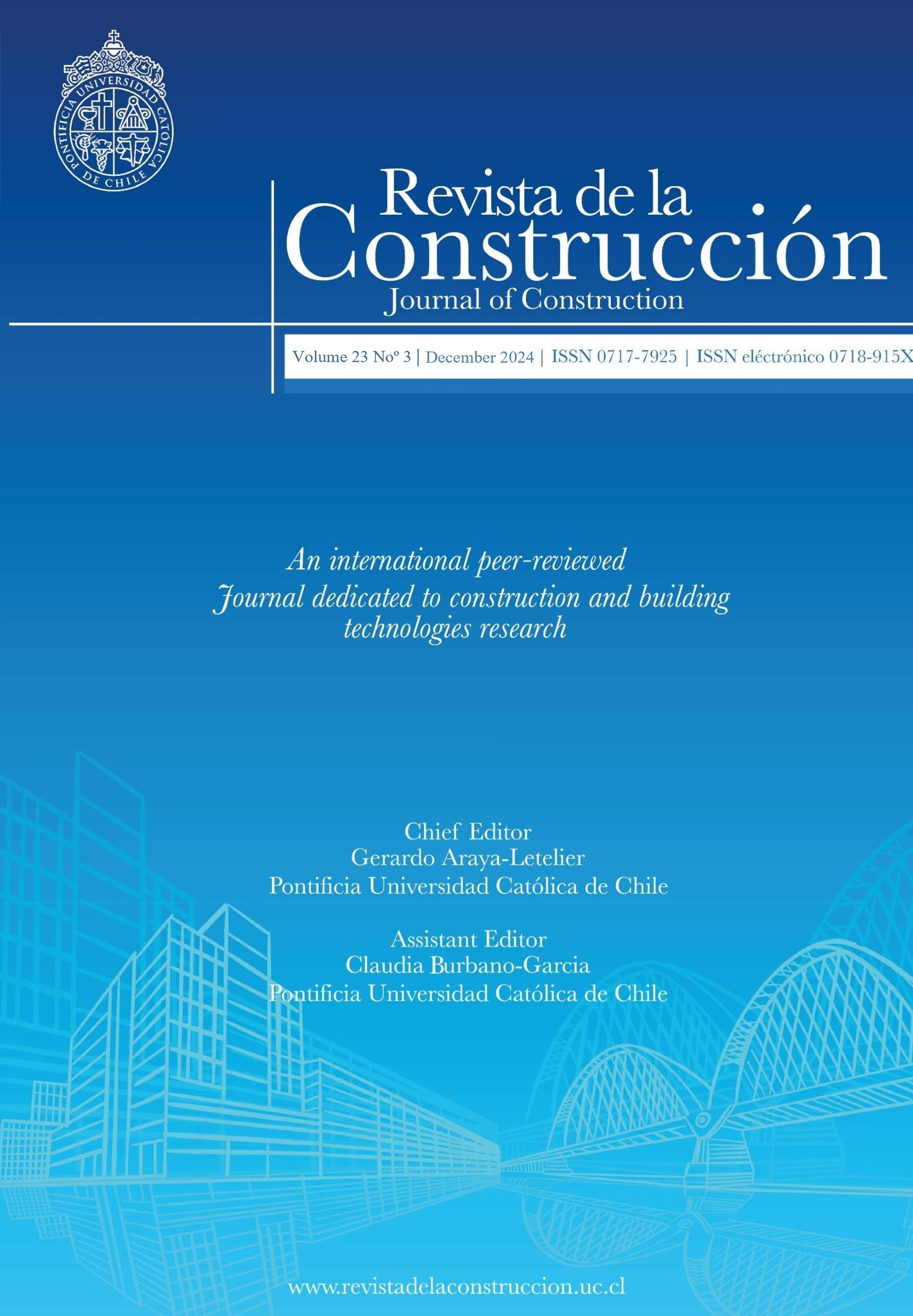Potential implementation of the woody biochar waste as an eco-friendly soil stabilization material in sandy environments
DOI:
https://doi.org/10.7764/RDLC.23.3.497Keywords:
Sand, Biochar, shear strength, interlocking, dilative characterAbstract
This experimental analysis aims to develop a fundamental understanding of the geotechnical properties of soils treated with an organic material named biochar. In this context, an experimental protocol was set using the Casagrande shear box apparatus to effectively demonstrate the combined influence of the biochar fraction (Fbio=0%, 5%, 10% and 15%), the initial relative density (Dr = 20%, Dr = 54%, and Dr = 90%), and the initial normal stress (σn = 100, 200, and 300 kPa) on the mechanical behavior of Chlef sand. The obtained results clearly show that biochar has a significant influence on the mechanical behavior of the tested materials. Additionally, the shear strength decreases with increasing biochar content up to a threshold value of (Fbio = 10%). Beyond that, the shear strength increases with the increase of biochar content up to the value of (Fbio = 15%) for all the considered parameters. The observed trend of increasing shear strength with the addition of the biochar content (Fbio = 15%) can be attributed to the amplification of the particle interlocking due to the presence of biochar particles between the large particles of Chlef sand, inducing an increase in the dilative character of the tested materials; offering implications for various geotechnical applications. Moreover, pertinent correlations were obtained between the residual shear strength and the grain size characteristics of the sand-biochar mixtures.
Downloads
References
Agrafioti, E., Bouras, G., Kalderis, D., and Diamadopoulos, E. (2013). Biochar production by sewage sludge pyrolysis. Journal of analytical and applied pyrolysis, 101, 72-78.
Awad, Y. M., Ok, Y. S., Abrigata, J., Beiyuan, J., Beckers, F., Tsang, D. C., and Rinklebe, J. (2018). Pine sawdust biomass and biochars at different pyroly-sis temperatures change soil redox processes. Science of the Total Environment, 625, 147-154.
Azaiez, H., Taiba, A. C., Mahmoudi, Y., and Belkhatir, M. (2021). Characterization of granular materials treated with fly ash for road infrastructure applications. Transportation Infrastructure Geotechnology, 8, 228-253.
Azaiez, H., Cherif Taiba, A., Mahmoudi, Y., and Belkhatir, M. (2021). Shear characteristics of fly ash improved sand as an embankment material for road infrastructure purpose. Innovative Infrastructure Solutions, 6(3), 148.
Abdelkader, B., Ahmed, A., Mostéfa, B., and Isam, S. (2016). Laboratory study of geotextiles performance on reinforced sandy soil. Journal of Earth Science, 27(6), 1060-1070.
Abdelkader, B., Arab, A., Sadek, M., and Shahrour, I. (2018). Laboratory investigation of the influence of geotextile on the stress–strain and volumetric change behavior of sand. Geotechnical and Geological Engineering, 36(4), 2077-2085.
Cai, H., Xu, L., Chen, G., Peng, C., Ke, F., Liu, Z., ... and Wan, X. (2016). Removal of fluoride from drinking water using modified ultrafine tea powder processed using a ball-mill. Applied Surface Science, 375, 74-84.
Cherif Taiba, A., Mahmoudi, Y., Belkhatir, M., and Baille, W. (2021). Assessment of the correlation between grain angularity parameter and friction index of sand containing low plastic fines. Geomechanics and Geoengineering, 16(2), 133-149.
Cherif Taiba, A., Mahmoudi, Y., Belkhatir, T. Witchmann, M., Baille, W (2021b). Threshold Silt Content Dependency on Particle Morphology (Shape and Size) of Granular Materials: Review with New Evidence. Acta geotechnica Slovenica 18 (1): 28-40. DOI: 10.18690/actageotechslov.18.1.28-40.2021
Cherif Taiba, A., Mahmoudi, Y. and Belkhatir, M. (2024). Discussion of “Experimental Study on Unconfined Compressive Strength of Rubberized Ce-mented Soil” by Jie He, Duanwei Guo, Dexin Song, Fangcheng Liu, Lei Zhang, and Qifeng Wen. KSCE J Civ Eng. https://doi.org/10.1007/s12205-024-1998-z
Cetin, E., Moghtaderi, B., Gupta, R., and Wall, T. F. (2004). Influence of pyrolysis conditions on the structure and gasification reactivity of biomass chars. Fuel, 83(16), 2139-2150.
Dai, Y., Zhang, N., Xing, C., Cui, Q., and Sun, Q. (2019). The adsorption, regeneration and engineering applications of biochar for removal organic pollu-tants: a review. Chemosphere, 223, 12-27.
Das, O., Sarmah, A. K., and Bhattacharyya, D. (2015). Structure–mechanics property relationship of waste derived biochars. Science of the Total Envi-ronment, 538, 611-620.
Doumi, K., Mahmoudi, Y., Cherif Taiba, A., Baille, W., and Belkhatir, M. (2021). Influence of the particle size on the flow potential and friction index of partially saturated sandy soils. Transportation Infrastructure Geotechnology, 1-25.
Downie, A., Crosky, A., Munroe, P., (2009). Physical properties of biochar. In: Lehmann, J., Joseph, S. (Eds.), Biochar for Environmental Management: Science and Technology, 1th ed. Earthscan Publication Ltd., London, UK; Sterling, VA, USA, pp. 13-32.
Elzobair, K.A., Stromberger, M.E., Ippolito, J.A., Lentz, R.D., (2016). Contrasting effects of biochar versus manure on soil microbial communities and enzyme activities in an Aridisol. Chemosphere 142, 145-152.
Hazout, L., Cherif Taiba, A., Mahmoudi, Y., and Belkhatir. M (2022). Deformation characteristics of natural river sand under compression loading incor-porating extreme particle diameters impacts. Marine Georesources and Geotechnology, https://doi.org/10.1080/1064119X.2022.2122090.
Kazemi, H.S.P, Dehhaghi. M, Yong S.O, Nizami. A.S, Khoshnevisan.B, Solange I. M, Aghbashlo. M, Tabatabaei, M, Su S. L. (2020). A comprehensive review of engineered biochar: Production, characteristics, and environmental applications. Journal of Cleaner Production 270.122462. doi.org/10.1016/j.jclepro.2020.122462
Latifi, N., A. S. A. Rashid, S. Siddiqua, and M. Z. A. Majid. (2016). “Strength measurement and textural characteristics of tropical residual soil stabilised with liquid polymer.” Measurement 91: 46–54. https://doi .org/10.1016/j.measurement.2016.05.029
Lehmann, J., Joseph, S., (2015). Biochar for Environmental Management: Science, Technology and Implementation. Routledge.
Li, H., Lu, X., Xu, Y., and Liu, H. (2019). How close is artificial biochar aging to natural biochar aging in fields? A meta-analysis. Geoderma, 352, 96-103.
Liu, J, Wang, Y, Kanungo, D. P, Wei, J, Bai, Y., Li, D, Lu, Y. (2019). Study on the Brittleness Characteristics of Sand Reinforced with Polypropylene Fiber and Polyurethane Organic Polymer. Fibers and Polymers, 20(3), 620-632. DOI :10.1007/s12221-019-8779-1
Lu, W., Ding, W., Zhang, J., Li, Y., Luo, J., Bolan, N., Xie, Z., (2014). Biochar suppressed the decomposition of organic carbon in a cultivated sandy loam soil: a negative priming effect. Soil Biol. Biochem. 76, 12-21.
Lyu, H., Gao, B., He, F., Zimmerman, A.R., Ding, C., Huang, H., Tang, J., (2018). Effects of ball milling on the physicochemical and sorptive properties of biochar: experimental observations and governing mechanisms. Environ. Pollut. 233, 54-63.
Mahmoudi, Y., Cherif Taiba, A., Hazout, L. Belkhatir, M., and Baille, W. (2020a). Packing Density and Overconsolidation Ratio Effects on the Mechani-cal Response of Granular Soils. Geotechnical and Geological Engineering journal, DOI 10.1007/s10706- 019-01061-2
Mahmoudi, Y. Cherif Taiba, A. Belkhatir, M. Baille, W and Wichtmann, T. (2020b). Characterization of mechanical behavior of binary granular assem-blies through the equivalent void ratio and equivalent state parameter. European Journal of Environmental and Civil Engineering. 24 (8) DOI.org/10.1080/19648189.2020.1775708
Mochamad A. B, A. Chegenizadehb, H,. Nikrazc (2015). Investigation of the strength of carbon-sand mixture. Procedia Engineering 102 (2015) 634-639, Doi: 10.1016/j.proeng.2015.01.153.
Nawagamuwa, U. P., and Wijesooriya, N. (2018). Use of fly ash to improve soil properties of drinking water treatment sludge. International Journal of Geo-Engineering, 9, 1-8.
NF P94-071-1 (1994). Sols : reconnaissance et essais - Essai de cisaillement rectiligne à la boîte - Partie 1 : cisaillement direct. AFNOR.
Pardo, G. S., Orense, R. P., and Sarmah, A. K. (2018). Cyclic strength of sand mixed with biochar: Some preliminary results. Soils and foundations, 58(1), 241-247.
Phanikumar, B. R., and Nagaraju, T. V. (2018). Effect of fly ash and rice husk ash on index and engineering properties of expansive clays. Geotechnical and Geological engineering, 36(6), 3425-3436.
Rodrigues De Amorim, R., Orense, R. P., Pardo, G. S., Sarmah, A. K., and Yan, W. M. (2020). Liquefaction resistance of sand amended with biochar. Géotechnique Letters, 10(2), 290-295.
Hussain, R., Ghosh, K. K., Garg, A., and Ravi, K. (2021). Effect of biochar produced from mesquite on the compaction characteristics and shear strength of a clayey sand. Geotechnical and Geological Engineering, 39, 1117-1131.
Su, T., and X. C. Zhang. (2011). Effects of EN-1 soil stabilizer on slope runoff hydraulic characteristics of Pisha sandstone stabilized soil. Trans. Chin. Soc. Agric. Mach. 42 (11): 68–75.
Tabatabaei, M., Aghbashlo, M., Dehhaghi, M., Kazemi Shariat Panahi, H., Mollahosseini, A., Hosseini, M., (2019). Reactor technologies for biodiesel production and processing: a review. Prog. Energy Combust. Sci. 74, 239-303.
Taibi, A., Mahmoudi, Y., Cherif Taiba, A., Azaiez, H., and Belkhatir, M. (2023). Fly ash effects on the stress-dilatancy relation of coarse soils: Particle morphology role. Geotechnical and Geological Engineering, 41(4), 2517-2536.
Taibi, A., Mahmoudi, Y., Taiba, A. C., Azaiez, H., and Belkhatir, M. (2023). Influence of particle size index on shear properties of cohesionless soils ad-mixture with fly ash binder. Journal of Geo Engineering, 18(2).
Tan, X.-f., Liu, Y.-g., Gu, Y.-l., Xu, Y., Zeng, G.-m., Hu, X.-j., Liu, S.-b., Wang, X., Liu, S.- m., Li, J., (2016). Biochar-based nano-composites for the decon-tamination of wastewater: a review. Bioresour. Technol. 212, 318-333.
Wang, B., Gao, B., Fang, J., (2017). Recent advances in engineered biochar productions and applications. Crit. Rev. Environ. Sci. Technol. 47, 2158-2207.
Yek, P.N.Y., Peng, W., Wong, C.C., Liew, R.K., Ho, Y.L., Mahari, W.A.W., Azwar, E., Yuan, T.Q., Tabatabaei, M., Aghbashlo, M., (2020). Engineered biochar via microwave CO2 and steam pyrolysis to treat carcinogenic Congo Red Dye. J. Hazard Mater. 122636.
Yi, S., Sun, Y., Hu, X., Xu, H., Gao, B., Wu, J., (2018). Porous nano-cerium oxide wood chip biochar composites for aqueous levofloxacin removal and sorption mechanism insights. Environ. Sci. Pollut. Res. 25, 25629-25637.
Zickler, G., Schoberl, T., Paris, O., (2006). Mechanical properties of pyrolysed wood: a nanoindentation study. Philos. Mag. A 86, 1373-1386.Alhazmi, T., and McCaffer, R. (2000). Project procurement system selection model. Journal of Construction Engineering and Management, 126(3), 176-184.
Downloads
Published
How to Cite
Issue
Section
License
Copyright (c) 2024 Mohamed Megrousse, Mahmoudi Youcef, Abdellah Cherif Taiba, Hamou Azaiez, Mostefa Belkhatir

This work is licensed under a Creative Commons Attribution-NonCommercial-NoDerivatives 4.0 International License.








